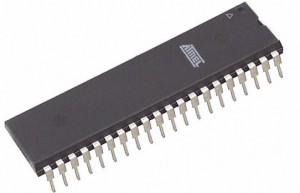How Microcontroller Works?
Microcontroller is nothing but the CPU (Central Processing Unit) with supporting components like memory and I/O peripherals. If a computer matches a majority of these characteristics then you called it as “microcomputer”. Basically this microcontroller takes an instructions (in the form of programming and execute them one by one in less than millionth of a second. This way through art of programming we instruct microcontroller and use its features to perform specific task.
Example, In television set microcontroller sitting inside of your television box takes button pressed input from remote control and display output on TV screen. The controller controls the channel selector, volume system and certain adjustment on the picture tube electronics such as tint and brightness.
What is AVR Microcontroller?
Microcontroller is tiny little computer in single IC (Integrated Circuit). Microcontrollers are first distinguished on bit number of internal data bus: 4 bit, 8-bit, 16-bit, 32-bit. This number of bits can be interpreted as the length of data that can be processed in order of controller.

Microcontrollers has a processor, memory, input and output. These little chips can be programmed to perform certain task say for example: Interaction of physical world using controlling LED, buttons, displays, sensors etc. These chips are powerful enough so not only pins can programmed for digital input and output but also most microcontroller comes with built in peripherals like Timers, Analog to Digital Converter (ADC), Serial Interface, Pulse Width Modulation (PWM). In this series of tutorials we will be focusing on ATmega32A which is avr microcontroller chip manufactured by Atmel Inc
How to choose Microcontroller?
There are couples of things we need to makes sure before we select microcontroller for our application or project. Those are listed as below,
- Make a list of required hardware interfaces
- Examine software architecture
- Figure out memory needs
- Cost and power constraints
- Market availability of microcontroller chip
- Find out supported compiler and tools
This is very important task because there are number of technical features needs to be considered. There are also business case issues such as cost and lead time that can challenge a project. In future I will write more about each aspect but for this article provided information is enough.
Which Microcontroller should I use?
Most of a time when we are working with microcontroller as a beginner and hobbyist level some of parameters user need to take into consideration,
- Good Resources (in terms of example projects, quality documentation, support)
- Choose economical or effective price range
- Handy design and simple architecture so that it would be easy to program. For example 40 pins (DIP) is easier to handle than 140 pins (SMD).
- Flash ROM: The controller should able to reprogram several times. Let’s say 1000 times at least.
- In System Programmability (ISP): You need inexpensive programmer & doesn’t need very expensive programmer circuit to upgrade firmware.
- Free software needs to be available like compiler, example: GCC & Flash utility tools (to load output file into microcontroller). It’s always depends on task that which microcontroller is well suited.
Why to choose AVR Microcontroller?
A number of factors make AVR microcontroller a good choice especially for beginner,
- Easy to Code: AVR were designed from ground up to allow easy and efficient programming in high level languages with a particular focus on C language
- Easy to Program: The combination of on chip reprogrammable flash memory and In-System programming interface keeps the process of transferring software into microcontroller chip simple and easy.
- Powerful and Inexpensive: AVR chips are powerful by performance (1 MIPS/MHz and clock upto 16MHz and space upto 128K of flash program memory and 4K EEPROM and SRAM at low prices. Most AVR additionally includes in-built peripherals such as UART and ADC (Analog to Digital Converter).
- Hobbyist Friendly: Most of AVR chips comes in easy to use 8-20, 28 or 40 pin dual in-line package (DIP) which makes them bread board friendly and can be ordered in unit quantities from local resellers or distributors.
 BINARYUPDATES.COM EMBEDDED SYSTEMS TRAINING
BINARYUPDATES.COM EMBEDDED SYSTEMS TRAINING
